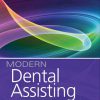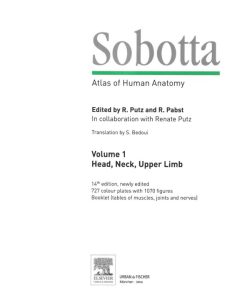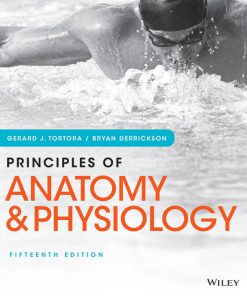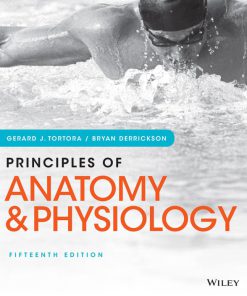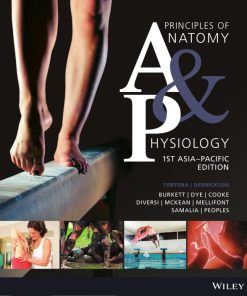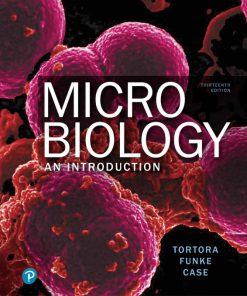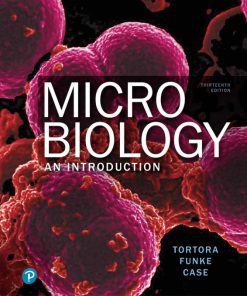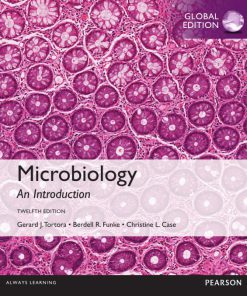Principles of Human Anatomy 14th Edition by Gerard Tortora, Mark Nielsen ISBN 1119320593 9781119320593
$50.00 Original price was: $50.00.$25.00Current price is: $25.00.
Authors:Gerard J. Tortora; Mark Nielsen , Series:Anatomy [134] , Tags:Science; Life Sciences; Human Anatomy & Physiology , Author sort:Tortora, Gerard J. & Nielsen, Mark , Ids:9781119285038 , Languages:Languages:eng , Published:Published:Sep 2017 , Publisher:Wiley , Comments:Comments:A market-leading text through its many editions, the 13th edition of Principles of Human Anatomy, 14th Edition continues to successfully blend visual and textual elements to illuminate the complexities of human anatomy. Written for the 1-term human anatomy course, the 14th edition raises the standard for excellence in this discipline with its enhanced illustration program, refined narrative, and the integrated design of dynamic resources like Real Anatomy 2.0 into the curriculum.
Principles of Human Anatomy 14th Edition by Gerard J. Tortora, Mark Nielsen – Ebook PDF Instant Download/Delivery. 1119320593, 978-1119320593
Full download Principles of Human Anatomy 14th Edition after payment
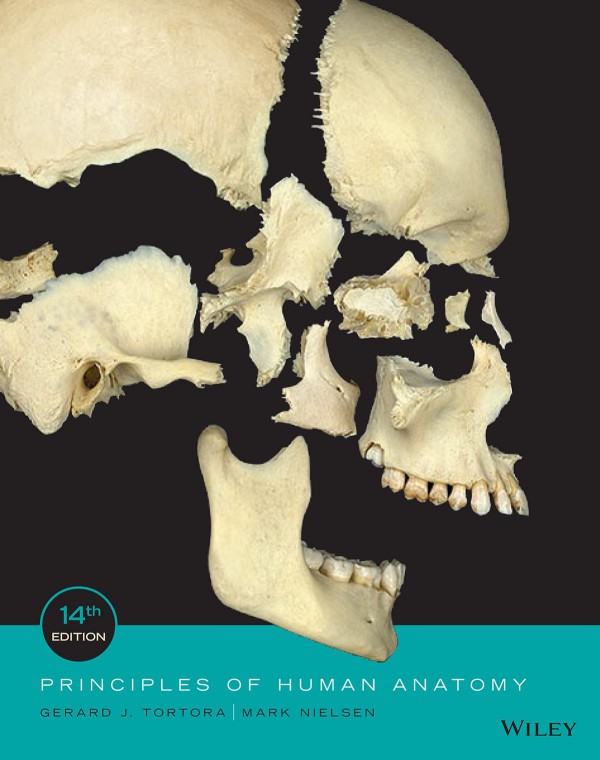
Product details:
ISBN 10: 1119320593
ISBN 13: 978-1119320593
Author: Gerard J. Tortora, Mark Nielsen
Immerse yourself in the spectacular visuals and dynamic content of Principles of Human Anatomy, 14th Edition. Designed for the 1-term Human Anatomy course, this 14th edition raises the standard for excellence in this discipline with its enhanced illustration program, refined narrative, and dynamic resources. Principles of Human Anatomy is a rich digital experience, giving students the ability to learn and explore human anatomy both inside and outside of the classroom.
Principles of Human Anatomy 14th Table of contents:
1. An Introduction to the Human Body
- 1.1 Anatomy Defined
- 1.2 Levels of Body Organization and Body Systems
- 1.3 Life Processes
- 1.4 Basic Anatomical Terminology
- 1.5 Body Cavities
- 1.6 Abdominopelvic Regions and Quadrants
- 1.7 The Human Body and Disease
- 1.8 Aging
- 1.9 Medical Imaging
- 1.10 Measuring the Human Body
- Chapter Review and Resource Summary
- Critical Thinking Questions
- Answers to Figure Questions
2. Cells
- 2.1 A Generalized Cell
- 2.2 The Plasma Membrane
- 2.3 Cytoplasm
- 2.4 Nucleus
- 2.5 Cell Division
- 2.6 Cellular Diversity
- 2.7 Aging and Cells
- Key Medical Terms Associated with Cells
- Chapter Review and Resource Summary
- Critical Thinking Questions
- Answers to Figure Questions
3. Tissues
- 3.1 Types of Tissues
- 3.2 Cell Junctions
- 3.3 Comparison Between Epithelial and Connective Tissues
- 3.4 Epithelial Tissue
- 3.5 Connective Tissue
- 3.6 Membranes
- 3.7 Muscular Tissue
- 3.8 Nervous Tissue
- 3.9 Aging and Tissues
- Key Medical Terms Associated with Tissues
- Chapter Review and Resource Summary
- Critical Thinking Questions
- Answers to Figure Questions
4. Development
- 4.1 Principles of Development
- 4.2 Embryonic Period
- 4.3 Fetal Period
- 4.4 Maternal Changes During Pregnancy
- 4.5 Labor
- Key Medical Terms Associated with Development
- Chapter Review and Resource Summary
- Critical Thinking Questions
- Answers to Figure Questions
5. The Integumentary System
- 5.1 Structure of the Skin
- 5.2 Accessory Structures of the Skin
- 5.3 Types of Skin
- 5.4 Functions of the Skin
- 5.5 Development of the Integumentary System
- 5.6 Aging and the Integumentary System
- Key Medical Terms Associated with the Integumentary System
- Chapter Review and Resource Summary
- Critical Thinking Questions
- Answers to Figure Questions
6. Bone Tissue
- 6.1 Functions of Bone and the Skeletal System
- 6.2 Types of Bones
- 6.3 Anatomy of a Bone
- 6.4 Bone Surface Markings
- 6.5 Histology of Bone Tissue
- 6.6 Blood and Nerve Supply of Bone
- 6.7 Bone Formation
- 6.8 Fractures
- 6.9 Exercise and Bone Tissue
- 6.10 Aging and Bone Tissue
- 6.11 Factors Affecting Bone Growth
- Key Medical Terms Associated with Bone Tissue
- Chapter Review and Resource Summary
- Critical Thinking Questions
- Answers to Figure Questions
7. The Skeletal System: The Axial Skeleton
- 7.1 Divisions of the Skeletal System
- 7.2 Skull
- 7.3 Hyoid Bone
- 7.4 Vertebral Column
- 7.5 Thorax
- Key Medical Terms Associated with the Axial Skeleton
- Chapter Review and Resource Summary
- Critical Thinking Questions
- Answers to Figure Questions
8. The Skeletal System: The Appendicular Skeleton
- 8.1 Skeleton of the Upper Limb
- 8.2 Skeleton of the Lower Limb
- 8.3 False and True Pelves
- 8.4 Comparison of Female and Male Pelves
- 8.5 Comparison of Pectoral and Pelvic Girdles
- 8.6 Development of the Skeletal System
- Key Medical Terms Associated with Appendicular Skeleton
- Chapter Review and Resource Summary
- Critical Thinking Questions
- Answers to Figure Questions
9. Joints
- 9.1 Joint Classifications
- 9.2 Fibrous Joints
- 9.3 Cartilaginous Joints
- 9.4 Synovial Joints
- 9.5 Types of Movements at Synovial Joints
- 9.6 Types of Synovial Joints
- 9.7 Factors Affecting Contact and Range of Motion at Synovial Joints
- 9.8 Selected Joints of the Body
- 9.9 Aging and Joints
- Key Medical Terms Associated with Joints
- Chapter Review and Resource Summary
- Critical Thinking Questions
- Answers to Figure Questions
10. Muscular Tissue
- 10.1 Overview of Muscular Tissue
- 10.2 Skeletal Muscle Tissue Structure
- 10.3 Skeletal Muscle Tissue Function
- 10.4 Types of Skeletal Muscle Fibers
- 10.5 Exercise and Skeletal Muscle Tissue
- 10.6 Cardiac Muscle Tissue
- 10.7 Smooth Muscle Tissue
- 10.8 Development of Muscles
- 10.9 Aging and Muscular Tissue
- Key Medical Terms Associated with Muscular Tissue
- Chapter Review and Resource Summary
- Critical Thinking Questions
- Answers to Figure Questions
11. The Muscular System
- 11.1 How Skeletal Muscles Produce Movements
- 11.2 How Skeletal Muscles Are Named
- 11.3 Principal Skeletal Muscles
- Key Medical Terms Associated with the Muscular System
- Chapter Review and Resource Summary
- Critical Thinking Questions
- Answers to Figure Questions
12. The Cardiovascular System: Blood
- 12.1 Functions of Blood
- 12.2 Physical Characteristics of Blood
- 12.3 Components of Blood
- 12.4 Formation of Blood Cells
- 12.5 Red Blood Cells
- 12.6 White Blood Cells
- 12.7 Platelets
- 12.8 Stem Cell Transplants from Bone Marrow and Cord-Blood
- Key Medical Terms Associated with Blood
- Chapter Review and Resource Summary
- Critical Thinking Questions
- Answers to Figure Questions
13. The Cardiovascular System: The Heart
- 13.1 Location and Surface Projection of the Heart
- 13.2 Structure and Function of the Heart
- 13.3 Circulation of Blood
- 13.4 Cardiac Conduction System and Innervation
- 13.5 Cardiac Cycle (Heartbeat)
- 13.6 Heart Sounds
- 13.7 Exercise and the Heart
- 13.8 Development of the Heart
- Key Medical Terms Associated with the Heart
- Chapter Review and Resource Summary
- Critical Thinking Questions
- Answers to Figure Questions
14. The Cardiovascular System: Blood Vessels
- 14.1 Anatomy of Blood Vessels
- 14.2 Circulatory Routes—Systemic Circulation
- 14.3 Circulatory Routes—Hepatic Portal Circulation
- 14.4 Circulatory Routes—Pulmonary Circulation
- 14.5 Circulatory Routes—Fetal Circulation
- 14.6 Development of Blood Vessels and Blood
- 14.7 Aging and the Cardiovascular System
- Key Medical Terms Associated with Blood Vessels
- Chapter Review and Resource Summary
- Critical Thinking Questions
- Answers to Figure Questions
15. The Lymphatic (Lymphoid) System and Immunity
- 15.1 The Concept of Immunity
- 15.2 Lymphatic System Structure and Functions
- 15.3 Lymphatic Vessels and Lymph Circulation
- 15.4 Lymphatic Organs and Tissues
- 15.5 Principal Groups of Lymph Nodes
- 15.6 Development of Lymphatic Tissues
- 15.7 Aging and the Lymphatic System
- Key Medical Terms Associated with the Lymphatic System and Immunity
- Chapter Review and Resource Summary
- Critical Thinking Questions
- Answers to Figure Questions
16. Nervous Tissue
- 16.1 Overview of the Nervous System
- 16.2 Histology and Functions of Neurons
- 16.3 Histology and Function of Neuroglia
- 16.4 Neural Circuits
- 16.5 Regeneration and Neurogenesis
- Key Medical Terms Associated with Nervous Tissue
- Chapter Review and Resource Summary
- Critical Thinking Questions
- Answers to Figure Questions
17. The Spinal Cord and the Spinal Nerves
- 17.1 Spinal Cord Anatomy
- 17.2 Spinal Nerves
- 17.3 Spinal Cord Functions
- Key Medical Terms Associated with the Spinal Cord and the Spinal Nerves
- Chapter Review and Resource Summary
- Critical Thinking Questions
- Answers to Figure Questions
18. The Brain and the Cranial Nerves
- 18.1 Development and General Structure of the Brain
- 18.2 Protection and Blood Supply
- 18.3 The Brainstem and Reticular Formation
- 18.4 The Cerebellum
- 18.5 The Diencephalon
- 18.6 The Cerebrum
- 18.7 Functional Organization of the Cerebral Cortex
- 18.8 Aging and the Nervous System
- 18.9 Cranial Nerves
- Key Medical Terms Associated with the Brain and the Cranial Nerves
- Chapter Review and Resource Summary
- Critical Thinking Questions
- Answers to Figure Questions
19. The Autonomic Nervous System
- 19.1 Comparison of Somatic and Autonomic Nervous Systems
- 19.2 Anatomy of Autonomic Motor Pathways
- 19.3 Structure of the Sympathetic Division
- 19.4 Structure of the Parasympathetic Division
- 19.5 ANS Neurotransmitters and Receptors
- 19.6 Functions of the ANS
- 19.7 Integration and Control of Autonomic Functions
- Key Medical Terms Associated with the Autonomic Nervous System
- Chapter Review and Resource Summary
- Critical Thinking Questions
- Answers to Figure Questions
20. Somatic Senses and Motor Control
- 20.1 Overview of Sensations
- 20.2 Somatic Sensations
- 20.3 Somatic Sensory Pathways
- 20.4 Somatic Motor Pathways
- 20.5 Integration of Sensory Input and Motor Output
- Key Medical Terms Associated with Somatic Senses and Motor Control
- Chapter Review and Resource Summary
- Critical Thinking Questions
- Answers to Figure Questions
21. Special Senses
- 21.1 Olfaction: Sense of Smell
- 21.2 Gustation: Sense of Taste
- 21.3 Vision
- 21.4 Hearing and Equilibrium
- 21.5 Development of the Eyes and Ears
- 21.6 Aging and the Special Senses
- Key Medical Terms Associated with Special Senses
- Chapter Review and Resource Summary
- Critical Thinking Questions
- Answers to Figure Questions
22. The Endocrine System
- 22.1 Endocrine Glands Defined
- 22.2 Hormones
- 22.3 Hypothalamus and Pituitary Gland
- 22.4 Pineal Gland and Thymus
- 22.5 Thyroid Gland and Parathyroid Glands
- 22.6 Adrenal Glands
- 22.7 Pancreas
- 22.8 Ovaries and Testes
- 22.9 Other Endocrine Tissues
- 22.10 Development of the Endocrine System
- 22.11 Aging and the Endocrine System
- Key Medical Terms Associated with the Endocrine System
- Chapter Review and Resource Summary
- Critical Thinking Questions
- Answers to Figure Questions
23. The Respiratory System
- 23.1 Respiratory System Anatomy
- 23.2 Upper Respiratory System Anatomy
- 23.3 Lower Respiratory System Anatomy
- 23.4 Mechanics of Pulmonary Ventilation (Breathing)
- 23.5 Regulation of Breathing
- 23.6 Exercise and the Respiratory System
- 23.7 Development of the Respiratory System
- 23.8 Aging and the Respiratory System
- Key Medical Terms Associated with the Respiratory System
- Chapter Review and Resource Summary
- Critical Thinking Questions
- Answers to Figure Questions
24. The Digestive System
- 24.1 Overview of the Digestive System
- 24.2 Layers of the GI Tract
- 24.3 Peritoneum
- 24.4 Accessory Digestive Organs
- 24.5 Movements of the GI Tract
- 24.6 Digestion and Absorption
- 24.7 Development of the Digestive System
- 24.8 Aging and the Digestive System
- Key Medical Terms Associated with the Digestive System
- Chapter Review and Resource Summary
- Critical Thinking Questions
- Answers to Figure Questions
25. The Urinary System
- 25.1 Kidneys
- 25.2 Ureters
- 25.3 Urinary Bladder
- 25.4 Urethra
- 25.5 Urine Formation
- 25.6 Fluid and Electrolyte Balance
- 25.7 Aging and the Urinary System
- Key Medical Terms Associated with the Urinary System
- Chapter Review and Resource Summary
- Critical Thinking Questions
- Answers to Figure Questions
26. The Reproductive System
- 26.1 Female Reproductive System
- 26.2 Male Reproductive System
- 26.3 Reproductive Cycles
- 26.4 Development of the Reproductive System
- 26.5 Aging and the Reproductive System
- Key Medical Terms Associated with the Reproductive System
- Chapter Review and Resource Summary
- Critical Thinking Questions
- Answers to Figure Questions
People also search for Principles of Human Anatomy 14th:
tortora principles of human anatomy 15e
principles of human anatomy and physiology tortora pdf
biol 4580 principles of human anatomy and development
borrow principles of human anatomy
what are the 5 basic principles of anatomy and physiology



